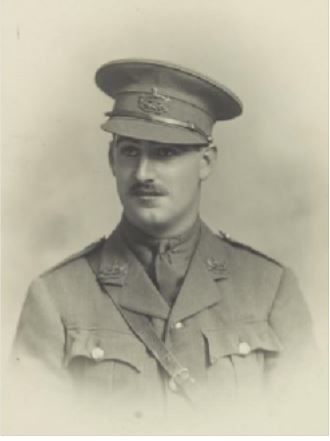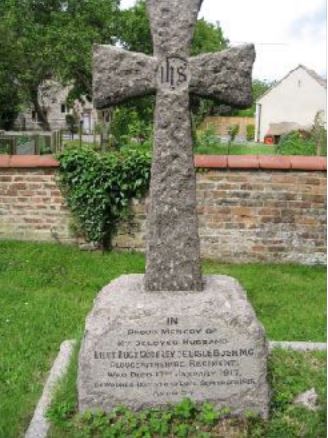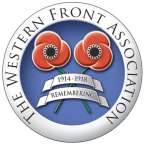1st Battalion, Gloucestershire Regiment

Hugh Godfrey de Lisle Bush was born on 1 April 1892 at The Elms, Alveston (near Thornbury), the son of Alfred George de Lisle Bush and Florence Katherine de Lisle Bush (née Lysaght). He was the eldest of three sons and a daughter born to the above. His father was an iron merchant and the family lived at Eastington Park, Stonehouse, Gloucestershire. This appears to be quite a ‘well to do’ family as Hugh’s parents had married in early 1890 at St Georges Church, Hanover Square, in London’s West End – well known as a venue for ‘society’ weddings.
Hugh was educated at Park Hill, Lyndhurst, Hampshire and Eton College, where he was a member of the school OTC and from 1906 to 1913 was a member of the Royal Gloucestershire Hussars Yeomanry, rising from the rank of Private to Second Lieutenant.
He applied for a commission in the Special Reserve of Officers on 13 August 1914, expressing a desire to serve in the Somerset Light Infantry. At the time of application, he gave his residence as Eastington Park; his occupation as a blast furnace assistant manager, with J Lysaght Ltd. The application was supported by the Vicar of Stonehouse.
On 15 August 1914 he was initially posted to 3rd (Reserve) Battalion of the Gloucestershire Regiment and later attached to the 1st Battalion, whom he joined on the Western Front on 20 September 1914.
He has an entry in the de Ruvigny’s Roll of Honour, which states that he was awarded the Military Cross (MC) for ‘… gallant conduct in the field, having rescued under heavy fire and brought again into action one of his machine guns with its compliment of men, which had been buried by a shell. He was also mentioned in despatches for gallant and distinguished service in the field.’
The MC relates to gallantry at Givenchy on 25 January 1915 (announced in the London Gazette of 10 March 1915). He was also Mentioned in Despatches for action on 31 May 1915 (announced in the London Gazette of 22 June 1915).
He took part in the Battle of Loos, where the 1st Gloucestershire Battalion, was part of 3 Brigade 1 Division, lV Corps. The War Diary of 1st Glosters states: On 5.10.15 Bn paraded at 5.30pm and marched via Mazingarbe to Loos relieving the 5 Berks and 1 Coy 9 Essex in trenches from G30. d.97 to H25. a.87. Relief completed at midnight. 6.10.15 Constant shelling chiefly enfilade along line of Chalk Pit Wood. 2 platoons of D Coy sent back to support trench in rear of Loos-Hulluch road, owing to trench being overcrowded. Casualties: Lt D’L Bush wounded; OR 1 killed 8 wounded.
Lieutenant Bush had sustained a gun shot wound in his right thigh, with a compound fracture of the lower third.
As his National Archives file WO339/22120 reveals, this was a serious wound which necessitated an immediate operation in France and for a while he was gravely ill and friends were summoned to his bedside. He also had a mild attack of tetanus. On 23 October 1915 he was repatriated to King Edward Vll’s Hospital in London, where he remained until the end of that year.
He left hospital on sick leave with a small sinus leading down to the bone on the outer side of his right thigh. He had recurring abscesses in the wound, the infections often causing temperatures up to 103 degrees F and attacks of shivering. He also had abscesses in the calf of his left leg.
His condition improved little during the course of 1916 and on 27 December he entered Mrs Burns’ Hospital for Officers, Stodley Knowle, Torquay, which was a Red Cross Hospital. His latest Army Medical Board had advised an operation. His wound was not healing properly and he had limitation to the movement of his knee joint: generally, his health was poor and spirit low.
He underwent an operation on 4 January 1917 to try to clear the infection in the wound. Unfortunately, this was unsuccessful and infection was now tracking down to the knee cap and joint and causing a fever.
At the request of his family, he was examined, under anaesthetic by a London surgeon. He discovered that his condition was such that amputation of the leg was a necessity to rid him of the infection – his general medical condition was too poor to withstand the alternative, prolonged treatment to fight it. The shock of the operation proved too great and at 7am on 17 January 1917 he died as a result of cardiac failure. He was 24 years of age.
A keen sportsman, an enthusiastic rider to the late Lord Fitzhardinge’s hounds and an excellent shot, Hugh had married Marjorie Critchley-Salmonson at Bridgenorth, Shropshire in the third quarter of 1915. She erected a stone cross over his grave in the churchyard of the Church of St Michael and All Angels, Easington, near Stonehouse. The inscription reads: In proud memory of my beloved husband Lieut Hugh Godfrey De Lisle Bush MC, Gloucestershire Regiment, who died 17th January 1917 of wounds received at Loos, September 1915. Aged 24.
Mrs de Lisle Bush remarried, becoming Mrs Jackson, and applied for Hugh’s medals on 15 January 1919.
Probate for Hugh’s estate (£1240 19s 10d) was granted to his younger brother Claude D’Arcy Stratton de Lisle Bush, himself a Captain in the Gloucestershire Regiment, who survived the war. He was to serve in the Glosters again in the Second World War and died in service on 22 January 1941 and is buried in the same churchyard as his brother.
Another brother, Captain John Stewart de Lisle Bush, was killed in action on 25 August 1917, age 21, whilst serving with 41 Squadron, Royal Flying Corps (attached from 1st (or 3rd Battalion) Somerset Light Infantry. He died at or near Walincourt and is buried in Honnechy British Cemetery (1-A-16), 8 km south west of Le Cateau.
Hugh shares a double grave plot with his parents: he and they have separate but very similar stone crosses. His father died at Eastington Park on 27 August 1929 and his mother died on 24 January 1949, aged 90.

Researched by Graham Adams 14 July 2011
